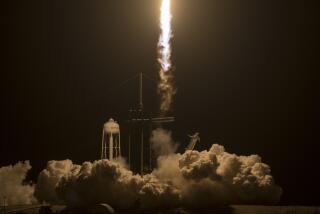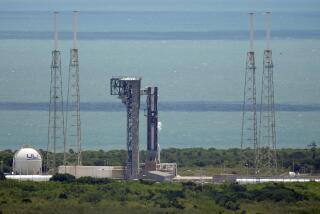Satellite Is Lost as Space Shuttle Tether Breaks
HOUSTON — A 12-mile tether connecting a half-ton satellite to the space shuttle Columbia broke without warning Sunday, allowing the $443-million satellite and its dangling leash to drift off into the void.
The seven astronauts aboard Columbia were not in any immediate danger as a result of the mishap, according to Mission Control at Johnson Space Center in Houston.
But the announcement from astronaut Jeffrey Hoffman that the cable had snapped nearly five hours into an electricity-generating experiment sent a shiver of anxiety through Mission Control.
“The tether has broken at the boom! The tether has broken! It is going away from us!” Hoffman reported about 5:30 p.m. PST.
The cord, just one-tenth of an inch thick, “very, very small, about the width of a round toothpick,” was taut, said John Dumoulin, NASA spokesman at Marshall Space Flight Center in Huntsville, Ala.
“The tether recoiled away from the shuttle. The satellite and the tether moved away from the shuttle and continues to move away from the shuttle,” Dumoulin said.
Both objects continued to orbit Earth at 17,500 mph. A video image showed the cable spiraling away from the camera like a white telephone cord against the jet black of space.
The satellite should eventually settle into its own orbit, higher than the 184-mile-high orbit of Columbia, the National Aeronautics and Space Administration said.
NASA spokesman James Hartsfield said that the crew was not forced to maneuver the spacecraft to keep it away from the cord. “It naturally separated from Columbia at the rate of about 80 feet per second. About 10 meters [30 feet] of tether are left inside the extendable boom” of the shuttle.
Within minutes the satellite and tether were miles away.
“The Columbia was not put in any danger,” Hartsfield added.
Flight director Chuck Shaw said: “There was no warning, there was nothing. The deploy was going very, very smoothly.”
NASA is working on plans to reel in the tether and retract the boom, probably this morning. The satellite, a joint project of NASA and the Italian Space Agency, was designed to generate up to 5,000 volts of electricity by towing the thin braid of cable through the stationary magnetic fields of space.
A first attempt to deploy the satellite failed in 1992 after a safety bolt accidentally limited the unspooling of the cable to about 800 feet. The second attempt to launch the satellite, a 5-foot diameter metal ball, was delayed a day when two computers jammed. One of the computers malfunctioned again Sunday, hours before the scheduled launching, but the astronauts repaired it.
Sunday’s deployment, coming two days after the shuttle lifted off from Kennedy Space Center, Fla., seemed to be going perfectly. All but 30 feet of the 12.8-mile cable had rolled out of a boom tower protruding from the shuttle’s cargo bay when it broke.
A hand-held camera view of the cable end showed it was frayed and it appeared to be burned through. “The cause of the broken tether is unknown,” Hartsfield said.
After seeing video of the curling tether later, Mission Control remarked: “Those are some tether dynamics we did not want to see.”
Shaw said that as of 8:30 p.m. PST, the satellite was 833 miles from the shuttle. The shuttle will end up lapping the satellite in 3 1/2 to 4 days, he added, but there are no plans to retrieve it.
“It is not a feasible thing” to retrieve the 1,200-pound satellite, he said.
NASA officials said the crew was fortunate that the tether did not break earlier, leaving more cord in the boom that could have wrapped around the shuttle. That scenario could have proven to be deadly.
“Well, if it had to break, it did it in the right place,” Mission Control told the crew.
A successful experiment with this satellite may have paved the way for new Space Age technology in which spacecraft, for example, could recharge their batteries during flight. The experiment was considered complex and dangerous.
Had a life-threatening situation arisen during the deployment, the astronauts had been trained to cut the cable and satellite loose.
The Columbia is due to return to Florida on March 7.
Times special correspondent Mike Clary reported from Miami, and staff writer Lianne Hart reported from Houston. Staff writer Eric Slater in Los Angeles contributed to this story.
More to Read
Sign up for Essential California
The most important California stories and recommendations in your inbox every morning.
You may occasionally receive promotional content from the Los Angeles Times.










